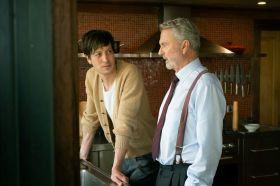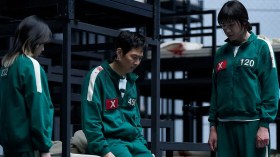In the wartime wilds of Fury, as in the historical conflict that it depicts, scant little stands the test of time. Not the deafening staccato stammer of machine gun fire, or the eerie silence that punctuates its intermittent absence. Not the mud and muck that squelches under foot as troops scurry across battlefields, or the careening convoys that attempt to carve paths into enemy territory. In an existence marked by constant carnage, nothing lasts but the attitude of nihilism and the finality of the end every soldier is desperately trying to avoid.
For Don ‘Wardaddy’ Collier (Brad Pitt, 12 Years a Slave) and his not-so-merry men on the side of the weary Allies, stability has favoured their group more than most. In a tank emblazoned with the anger of their emotional state, Boyd Swan (Shia LaBeouf, Nymphomaniac), Trini Garcia (Michael Peña, American Hustle) and Grady Travis (Jon Bernthal, The Wolf of Wall Street) have survived and stayed together longer than the bulk of their peers. After misfortune finally strikes their number, typist Norman Ellison (Logan Lerman, Noah) is sent to join their vehicle in active duty. Constrained to their claustrophobic quarters, they continue inching across fields and through throngs of Nazis, with killing their mission but persevering the true prize.
Fury is fictional, stemming simply and energetically from the keyboard of writer/director David Ayer, yet in its bleakness and brutality it purports to represent the real Second World War experience. Set in April of 1945 with victory close but Hitler unrelenting, it doesn’t skirt around the visceral ephemera of blood, guts and crushed skulls as filmed up close and in unflinching detail, nor from the machismo of men brooding together in confined quarters. Indeed, both violence and masculinity fall from Ayer’s familiar domain, scripting U-571, The Fast and the Furious, Training Day and S.W.A.T., and helming Harsh Times, Street Kings, End of Watch and Sabotage. Here, he matches combat and testosterone with contemplation and tension.
Maintaining the feature’s intense obsession with all things cruelly fleeting, each cycle of ruthlessness and reflection passes, though not without leaving an imprint. Vividly staged early sequences establish the pervading kill-or-be-killed mindset, sketch out standard character archetypes and group dynamics, and plunge the crew into their version of hell, then build towards two stunning setpieces. During a rare yet still menacing lull, Collier and Ellison steal an escape into modest creature comforts in a scene allowed to breathe to the point that its restraint and reserved atmosphere starts to seem normal, before reality encroaches and the movie’s message is once again enunciated. Later, back in the thick of the fight, their perpetual momentum grinds to a halt but their patriotic, dutiful spirits keep soaring, the transformation from ordinary men to hardened tools of slaughter celebrating “the best job in the world” one of the few lingering consequences.
Fittingly, in an effort about tragic impermanence that unsubtly underscores its theme at every opportunity – rather literally where Steven Price’s (Gravity) heavy-handed score is involved – Fury is marked by its smattering of astute, affecting moments. They’re the glue that stops the gore-filled affronts from collapsing into the usual over-the-top war clichés and blending into cinematographer Roman Vasyanov’s (The Necessary Death of Charlie Countryman) customary grey and brown visual palette. Excellent performances and perceptive framing hone in on the horror of the circumstances, focusing on the minutiae and eschewing the glory. Each actor, be it Pitt in his muscular command, LeBeouf displaying uncharacteristic solemnity, or Lerman’s fearful naivety, sparkles in small showings rather than complete arcs. Select shots, specifically those favouring the point-of-view perspective, evoke the inherent sadness and senselessness of the situation. The sentiment and relationships may be obvious, just as much as its action and on-screen personalities have been seen before, but in its glimpses of resonance beyond the heightened realism, Fury achieves what its characters seek – it endures.
Rating: 3 stars out of 5
Fury
Director: David Ayer
US, 2014, 134 mins
Release date: October 23
Distributor: Sony
Rated: MA
Actors:
Director:
Format:
Country:
Release:





